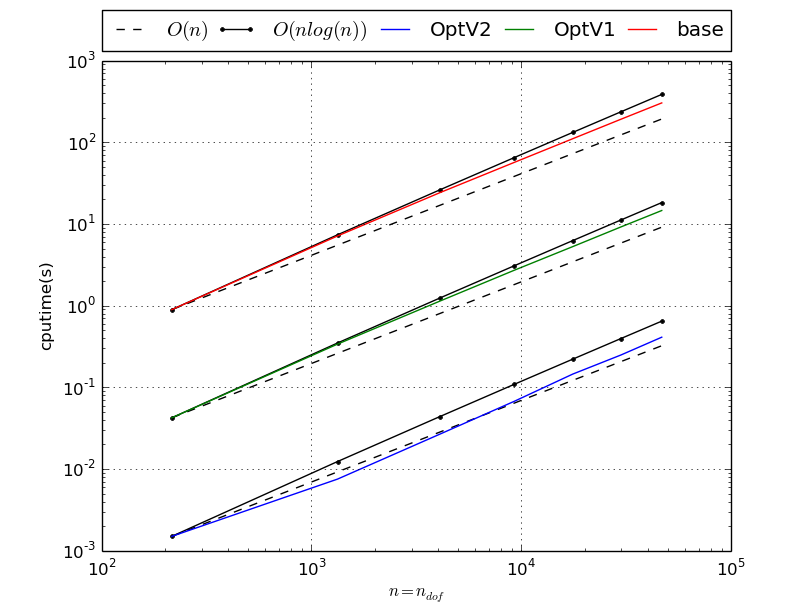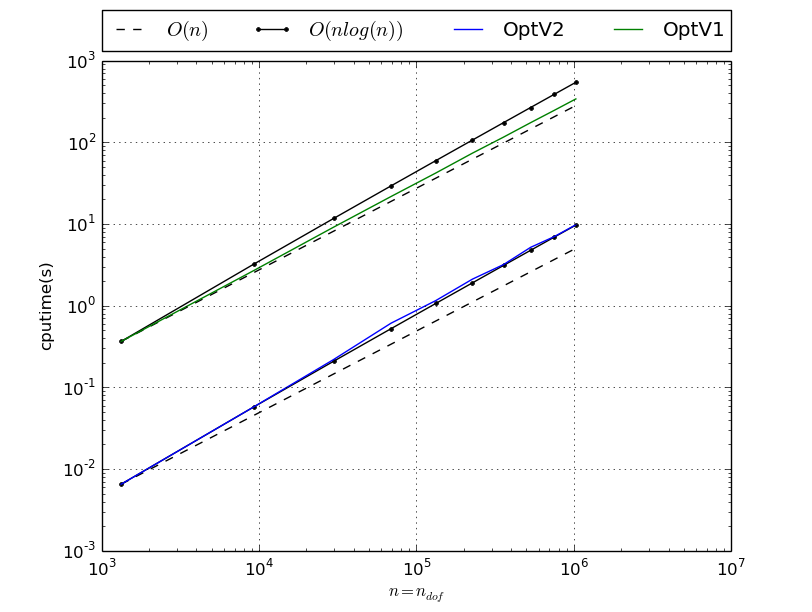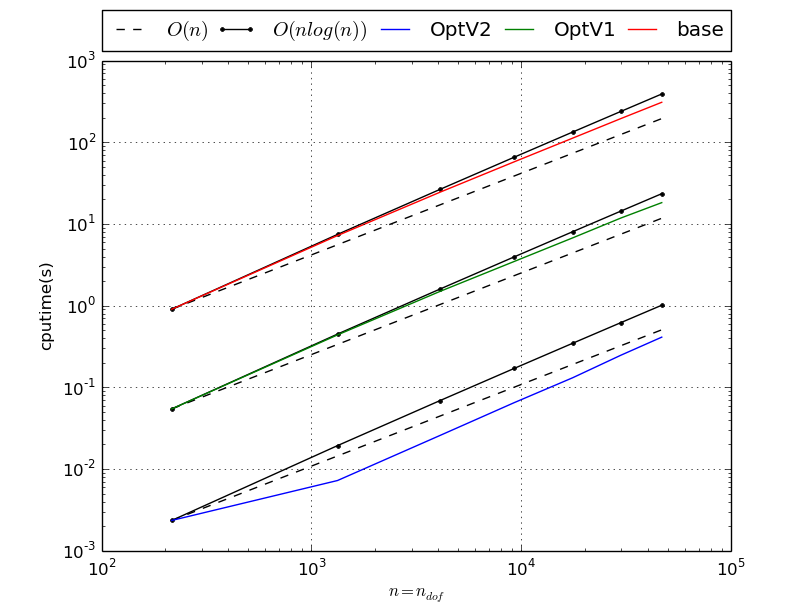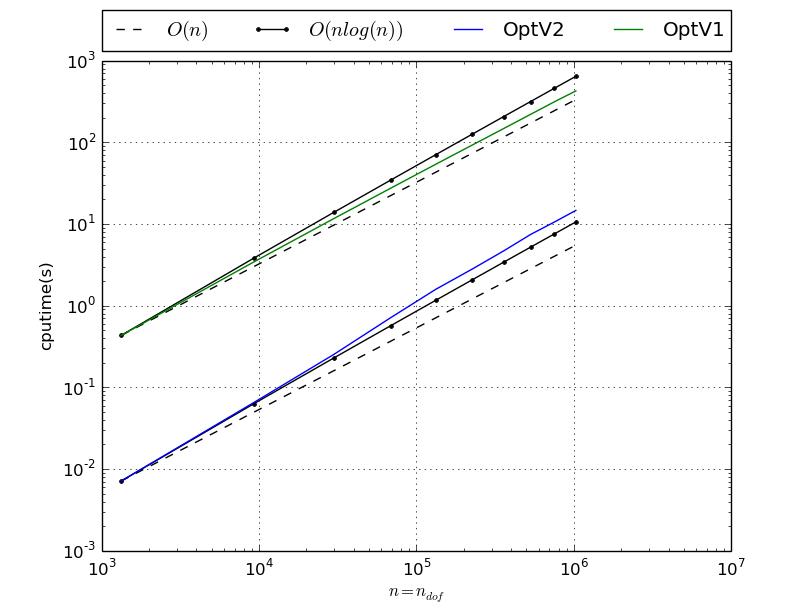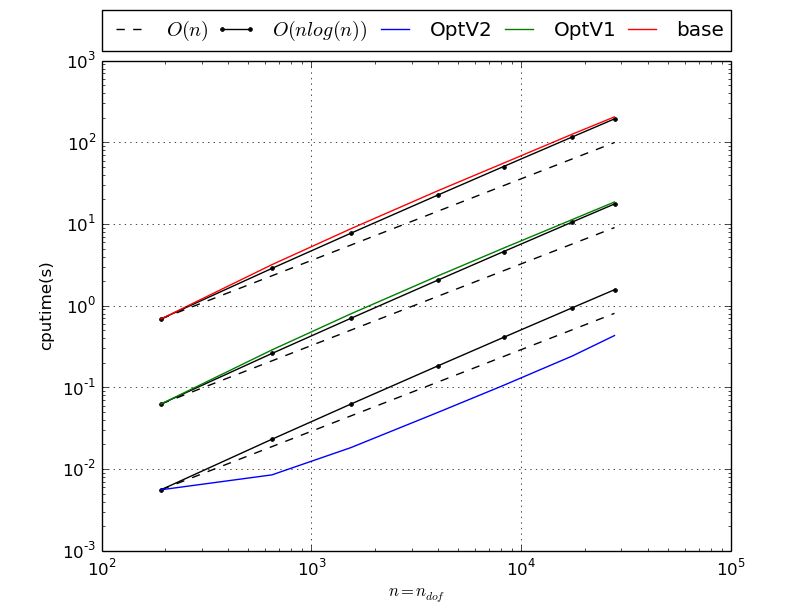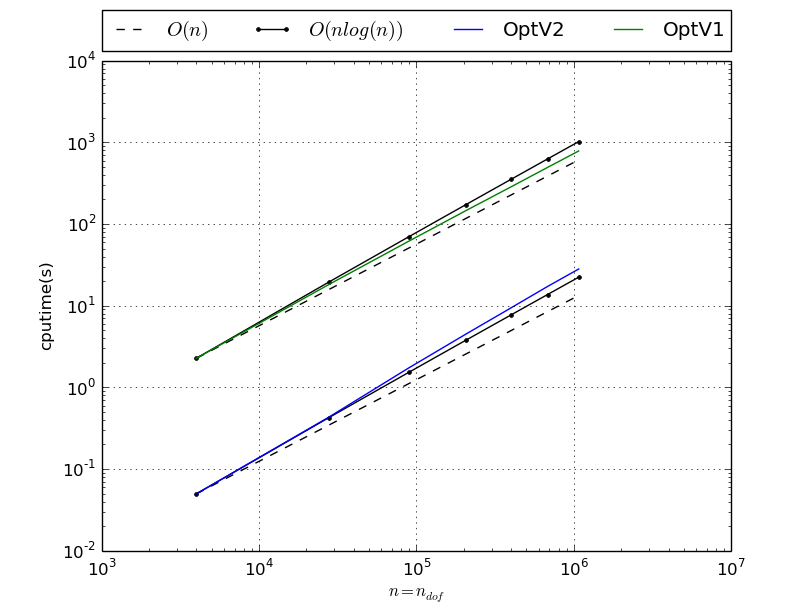3D benchmarks¶
Benchmark usage¶
- pyOptFEM.FEM3D.assemblyBench.assemblyBench([assembly=<string>, version=<string>, LN=<array>, meshname=<string>, meshdir=<string>, nbruns=<int>, la=<float>, mu=<float>, Num=<int>, tag=<string>, ...])
Benchmark code for
 -Lagrange finite element matrices defined in FEM3D.
-Lagrange finite element matrices defined in FEM3D.Parameters: - assembly –
Name of an assembly routine. The string should be :
- ‘MassAssembling3DP1’,
- ‘StiffAssembling3DP1’ (default)
- ‘StiffElasAssembling3DP1’
- versions – List of versions. Must be a list of any size whose elements may be {‘base’,’OptV1’,’OptV2’} (default : ['OptV2','OptV1','base'])
- meshname – Name of the medit mesh files. By default it is an empty string ‘’. It means it uses CubeMesh(N) function to generate meshes.
- meshdir – Directory location of medit mesh files. Used if meshname is not empty.
- LN –
array of integer values. <LN> contains the values of N. Used to generate meshes data via Th=CubeMesh(N) function if meshname is empty or via getMesh class to read FreeFEM++ meshes Th=getMesh(meshdir+’/’+meshname+str(N)+’.mesh’)
LN default value is range(5, 14, 2)
- nbruns – Number of runs on each mesh (default : 1)
- save – For saving benchmark results in a file (see parameters <output>, <outdir> and <tag>). (default : False)
- plot – For plotting computation times (default : True)
- output – Name used to set results file name (default : ‘bench2D’)
- outdir – Directory location of saved results file name (default : ‘./results’).
- tag – Specify a tag string added to filename
- la – the first Lame coefficient in Hooke’s law, denoted by
 . Used by functions for assembling the elastic stiffness matrix.
(default : 2)
. Used by functions for assembling the elastic stiffness matrix.
(default : 2) - mu – the second Lame coefficient in Hooke’s law, denoted by
 . Used by functions for assembling the elastic stiffness matrix.
(default : 0.3)
. Used by functions for assembling the elastic stiffness matrix.
(default : 0.3) - Num – Numbering choice. Used by functions for assembling the elastic stiffness matrix. (default : 0)
- assembly –
Mass Matrix¶
Benchmark of MassAssembling3DP1 with base, OptV1 and OptV2 versions (see Mass Matrix)
MassAssembling23P1 benchmark summary N nq ndof OptV2 OptV1 base 5 216 216 0.0015(s) 0.0424(s) 0.8962(s) x1.00 x28.29 x597.49 10 1331 1331 0.0075(s) 0.3390(s) 7.1521(s) x1.00 x44.96 x948.64 15 4096 4096 0.0268(s) 1.1413(s) 24.2836(s) x1.00 x42.55 x905.35 20 9261 9261 0.0677(s) 2.7240(s) 56.9878(s) x1.00 x40.26 x842.21 25 17576 17576 0.1457(s) 5.2998(s) 111.0287(s) x1.00 x36.38 x762.11 30 29791 29791 0.2493(s) 9.2205(s) 192.1030(s) x1.00 x36.99 x770.64 35 46656 46656 0.4121(s) 14.6558(s) 304.5941(s) x1.00 x35.57 x739.17 This tabular was built with the following code :
>>> from pyOptFEM.FEM3D import assemblyBench >>> assemblyBench(assembly='MassAssembling3DP1',LN=range(5,40,5)) CubeMesh(5): -> MassAssembling3DP1OptV2(nq=216, nme=750) run ( 1/ 1) : cputime=0.001254(s) - matrix 216-by-216 ... CubeMesh(35): -> MassAssembling3DP1base(nq=46656, nme=257250) run ( 1/ 1) : cputime=304.594078(s) - matrix 46656-by-46656
We also obtain
Benchmark of MassAssembling3DP1 with OptV2 and OptV1 versions
MassAssembling2DP1 benchmark summary N nq ndof OptV2 OptV1 10 1331 1331 0.0065(s) 0.3656(s) x1.00 x56.05 20 9261 9261 0.0578(s) 2.6968(s) x1.00 x46.70 30 29791 29791 0.2195(s) 9.1710(s) x1.00 x41.77 40 68921 68921 0.6109(s) 21.7386(s) x1.00 x35.59 50 132651 132651 1.1558(s) 42.1679(s) x1.00 x36.49 60 226981 226981 2.1182(s) 73.9066(s) x1.00 x34.89 70 357911 357911 3.1952(s) 116.2151(s) x1.00 x36.37 80 531441 531441 5.1899(s) 174.4814(s) x1.00 x33.62 90 753571 753571 7.0460(s) 247.8245(s) x1.00 x35.17 100 1030301 1030301 9.8218(s) 340.9609(s) x1.00 x34.71 This tabular was built with the following code :
>>> from pyOptFEM.FEM3D import assemblyBench >>> assemblyBench(assembly='MassAssembling3DP1',versions=['OptV2','OptV1'],LN=range(10,110,10)) CubeMesh(10): -> MassAssembling3DP1OptV2(nq=1331, nme=6000) run ( 1/ 1) : cputime=0.006523(s) - matrix 1331-by-1331 ... CubeMesh(100): -> MassAssembling3DP1OptV1(nq=1030301, nme=6000000) run ( 1/ 1) : cputime=340.960874(s) - matrix 1030301-by-1030301
We also obtain
Stiffness Matrix¶
Benchmark of StiffAssembling3DP1 with base, OptV1 and OptV2 versions
StiffAssembling3DP1 benchmark summary N nq ndof OptV2 OptV1 base 5 216 216 0.0024(s) 0.0546(s) 0.9065(s) x1.00 x23.22 x385.72 10 1331 1331 0.0072(s) 0.4396(s) 7.2347(s) x1.00 x60.68 x998.63 15 4096 4096 0.0258(s) 1.4985(s) 24.5593(s) x1.00 x58.08 x951.81 20 9261 9261 0.0652(s) 3.4915(s) 57.9647(s) x1.00 x53.55 x888.96 25 17576 17576 0.1315(s) 6.7851(s) 112.9478(s) x1.00 x51.61 x859.14 30 29791 29791 0.2479(s) 11.8616(s) 195.8290(s) x1.00 x47.85 x790.05 35 46656 46656 0.4126(s) 18.3069(s) 310.0601(s) x1.00 x44.37 x751.46 This tabular was built with the following code :
>>> from pyOptFEM.FEM3D import assemblyBench >>> assemblyBench(assembly='StiffAssembling3DP1',LN=range(5,40,5)) CubeMesh(5): -> StiffAssembling3DP1OptV2(nq=216, nme=750) run ( 1/ 1) : cputime=0.002350(s) - matrix 216-by-216 ... CubeMesh(35): -> StiffAssembling3DP1base(nq=46656, nme=257250) run ( 1/ 1) : cputime=310.060121(s) - matrix 46656-by-46656
We also obtain
Benchmark of StiffAssembling3DP1 with OptV2 and OptV1 versions
StiffAssembling3DP1 benchmark summary N nq ndof OptV2 OptV1 10 1331 1331 0.0071(s) 0.4329(s) x1.00 x60.68 20 9261 9261 0.0652(s) 3.4323(s) x1.00 x52.64 30 29791 29791 0.2525(s) 11.6349(s) x1.00 x46.07 40 68921 68921 0.7178(s) 27.6186(s) x1.00 x38.48 50 132651 132651 1.5883(s) 53.9955(s) x1.00 x34.00 60 226981 226981 2.8236(s) 93.1197(s) x1.00 x32.98 70 357911 357911 4.6881(s) 147.6608(s) x1.00 x31.50 80 531441 531441 7.4632(s) 220.7232(s) x1.00 x29.57 90 753571 753571 10.6093(s) 314.8404(s) x1.00 x29.68 100 1030301 1030301 14.7064(s) 427.0878(s) x1.00 x29.04 This tabular was built with the following code :
>>> from pyOptFEM.FEM3D import assemblyBench >>> assemblyBench(assembly='StiffAssembling3DP1',versions=['OptV2','OptV1'],LN=range(10,110,10)) CubeMesh(10): -> StiffAssembling3DP1OptV2(nq=1331, nme=6000) run ( 1/ 1) : cputime=0.007133(s) - matrix 1331-by-1331 ... CubeMesh(100): -> StiffAssembling3DP1OptV1(nq=1030301, nme=6000000) run ( 1/ 1) : cputime=427.087812(s) - matrix 1030301-by-1030301
We also obtain
Elastic Stiffness Matrix¶
Benchmark of StiffAssembling3DP1 with base, OptV1 and OptV2 versions
StiffAssembling3DP1 benchmark summary N nq ndof OptV2 OptV1 base 3 64 192 0.0056(s) 0.0626(s) 0.6896(s) x1.00 x11.23 x123.60 5 216 648 0.0085(s) 0.2877(s) 3.1838(s) x1.00 x33.87 x374.88 7 512 1536 0.0183(s) 0.7933(s) 8.7350(s) x1.00 x43.43 x478.25 10 1331 3993 0.0493(s) 2.3134(s) 25.5321(s) x1.00 x46.91 x517.74 13 2744 8232 0.1061(s) 5.0799(s) 55.8011(s) x1.00 x47.89 x526.04 17 5832 17496 0.2426(s) 11.3663(s) 126.2934(s) x1.00 x46.86 x520.66 20 9261 27783 0.4317(s) 18.6554(s) 205.4239(s) x1.00 x43.22 x475.90 This tabular was built with the following code :
>>> from pyOptFEM.FEM3D import assemblyBench >>> from numpy import * >>> assemblyBench(assembly='StiffElasAssembling3DP1',LN=array([3,5,7,10,13,17,20])) CubeMesh(3): -> StiffElasAssembling3DP1OptV2(nq=64, nme=162) run ( 1/ 1) : cputime=0.005579(s) - matrix 192-by-192 ... CubeMesh(20): -> StiffElasAssembling3DP1base(nq=9261, nme=48000) run ( 1/ 1) : cputime=205.423872(s) - matrix 27783-by-27783
Benchmark of StiffAssembling3DP1 with OptV1 and OptV2 versions
StiffAssembling3DP1 benchmark summary N nq ndof OptV2 OptV1 10 1331 3993 0.0497(s) 2.2711(s) x1.00 x45.73 20 9261 27783 0.4325(s) 18.1990(s) x1.00 x42.07 30 29791 89373 1.7316(s) 61.6716(s) x1.00 x35.62 40 68921 206763 4.5098(s) 146.4793(s) x1.00 x32.48 50 132651 397953 9.3904(s) 284.8776(s) x1.00 x30.34 60 226981 680943 17.2215(s) 494.1435(s) x1.00 x28.69 70 357911 1073733 28.1707(s) 785.3533(s) x1.00 x27.88 This tabular was built with the following code :
>>> from pyOptFEM.FEM3D import assemblyBench >>> assemblyBench(assembly='StiffElasAssembling3DP1',versions=['OptV2','OptV1'],LN=range(10,80,10)) CubeMesh(10): -> StiffElasAssembling3DP1OptV2(nq=1331, nme=6000) run ( 1/ 1) : cputime=0.049666(s) - matrix 3993-by-3993 ... CubeMesh(70): -> StiffElasAssembling3DP1OptV1(nq=357911, nme=2058000) run ( 1/ 1) : cputime=785.353305(s) - matrix 1073733-by-1073733
